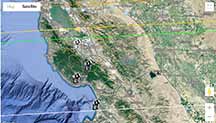


This is a high rank event and we're well inside the path here. A bit better odds if going up to upper UCSC or beyond. The star is dim at 14.1, but it's high overhead at 73 degrees altitude and the event lasts up to 15 seconds, so we can integrate decently and still get high resolution. The asteroid is 12.6 magnitude, and much brighter than the target star, so beware that on the charts, there'll be a much brighter target than the little dot for the star. It's in northern Leo, high overhead. At 73 degrees, we'll have to mount the scope as far up into the dovetail as possible. It may still not be possible to get the Watec from banging against the base, so we should probably plan to instead insert the Watec into the 2" diagonal. The focus point will then be quite different, so allow time to figure that out. Also, we'll have to use the 0.5x reducer on the nose and not the f/3.3 reducer as usual. That means the scale will be a bit different as well. The charts I just made assume the Watec will clear the base and we use the f/3.3, but that will be marginally possible, or perhaps not possible. If you want to try that way, then tilt the base to allow a little more clearance. I tested once before and 73 degrees was still barely possible, but any higher was not.
The dip is only 0.26 magnitudes, but for 15 seconds and with decent integration, if we get clear skies it should be do-able.
 |
 |
 |
There's another asteroid occultation 17 minutes earlier. It's a brighter event and deeper, but it requires driving to Marina to have a good chance at it. I'm not sure I want to do that. The odds of it hitting from Santa Cruz are nominally pretty low, well outside the 1-sigma limit. It's asteroid 1989-AL5. The odds from the centerline where I put down a station, is only 61%, with 60% clouds. Probably we'll skip this one and go for the 'from home' event by Ursula.
Clouds were gone well before event time. We had nice clear skies. I got a successful taping. Karl and Kirk both had trouble and no data: Karl had wiring/data cable trouble again, and not enough time to fix it. Kirk had trouble ID'ing the field, often a problem at high altitude.
Nolthenius
I got a successful taping and was optimistic it would yield a solid occultation. It's not impossible it might still work out, but PyMovie is not yet tuned to handle field rotation, for lack of a suitable test .avi showing strong field rotation. I've sent my .avi data to Bob Anderson and he's right now attempting to tune PyMovie for this right now. What would be ideal is to be able to have two or more static apertures set to tracking, and independently track their stars w/o reference to the other stars, as an option. This would optimize the target aperture to be unrelenting in its tracking (in cases like this one, where the dip in magnitude is small), while also getting suitable and very similar photometry on other stars. Another problem with my tape, is that there were saturated pixels on most frames, so the dip would be smaller than expected, and would also be different for a brighter or dimmer reference star. I set the 'saturated pixel' red flag limit at 216, still comfortably below the 2^8 8 bit = 256 level. For now, here's my results:
Analysis of this event is still ongoing, as I write this on March 12. A newer update of PyMovie is in the works, to handle videos with strong field rotation, and possible very thin cloud that is not obvious otherwise.